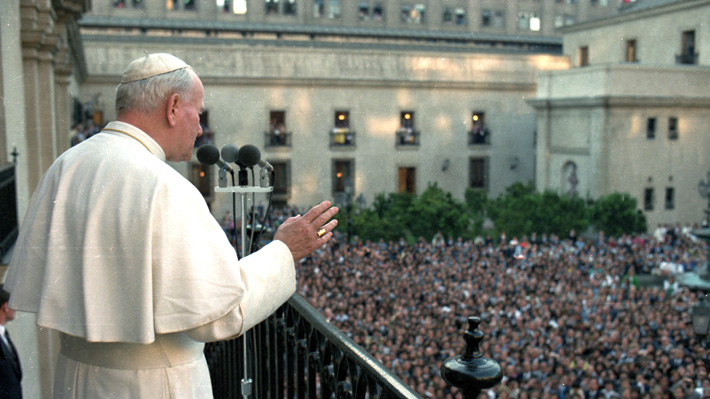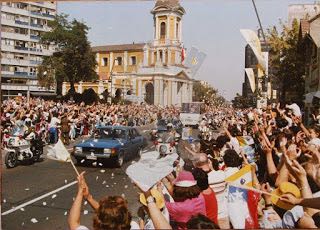The visit of John Paul II to Chile, made between April 1st and 6th, 1987, was that Pope's only trip to the country and the first visit of a supreme head of the Catholic Church to Chile.
This historical event, which was framed within the 33rd Apostolic Journey of John Paul II (in which he also visited Argentina and Uruguay), revolutionized the faithful of Catholicism and contracted multiple meanings and facts because it was carried out during the military government of Augusto Pinochet, and served to dispel to some extent the political tensions of that time.
John Paul II arrived at Comodoro Arturo Merino Benítez International Airport in Santiago on April 1st, on a six-day visit. At the air terminal, he was received by Augusto Pinochet and first lady Lucia Hiriart, along with military and government troops.
Later, from the Cathedral, he went to visit the Sanctuary of the Immaculate Conception on San Cristobal Hill, where he blessed Santiago and sent a message to the whole country.
When descending from the Alitalia flight that landed on the slab of the old Pudahuel airport, on Wednesday, April 1st, 1987, the first thing that John Paul II did was to kiss the Chilean soil. He came to spend six days in the country, which had never before received the visit of the Pontiff.
Karol Wojtyla's tour, then 66 years old, had a busy schedule and included eight cities: Antofagasta, La Serena, Valparaíso, Santiago, Concepción, Temuco, Puerto Montt and Punta Arenas.
As expected, due to the magnitude of the character and the present that was lived, the visit had a series of milestones.
The first one was the meeting he held the next day with a Pinochet dressed in a suit and tie. What it meant was a private appointment, it was converted by the regime as a show of support, with the image of both greeting the public from a balcony in La Moneda.
The Eucharist on Friday 3rd in the O'Higgins Park had a series of situations that would end up marking it. The massive presence of the public, which is estimated at one million people, and the pitched battle in which the enclosure was converted, due to clashes between those present and the regime's security agencies, and that included barricades, fire and bombs tear gas.
The use of gases affected even the Pope, who stopped his words for a few minutes observing what was happening in front of him.
After three days in the capital, with a brief transfer to Valparaíso, the Pontiff flew to Punta Arenas, from where he began to move from south to north until the end of April 6th with a mass in Antofagasta.
The Cold War determined the international context, where the conflict between the east, led by the United States, and the west, ruled by the Soviet Union, progressively increased the tension between these powers and their countries of influence. “Pope John Paul II was the result of that international historical situation. His nomination caused a stir because he was a Polish Pope, since Poland was under the Soviet Union. ”
Chile, meanwhile, lived in an authoritarian regime and society became polarized among the sympathizers and antagonists of the head of government. It was a complex picture, compared to what was happening abroad.
The Pope had also paid a visit to Poland, which was ruled by a leftist general, with an iron and authoritarian regime that was Jaruzelski, and was coming to Chile, which was also ruled by a general in a fervent way, but from the right and focused on neoliberalism.
Source: Channel 13, Catholic University of Chile






No comments:
Post a Comment